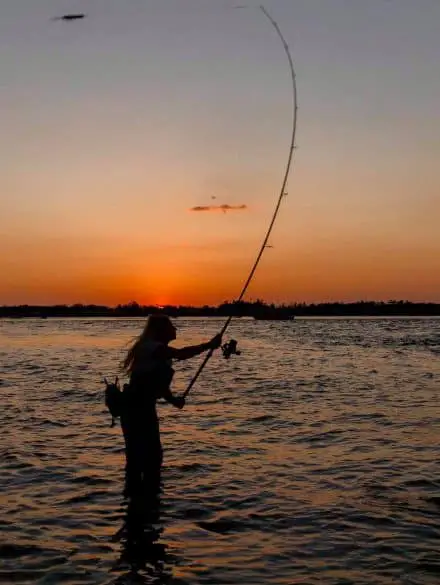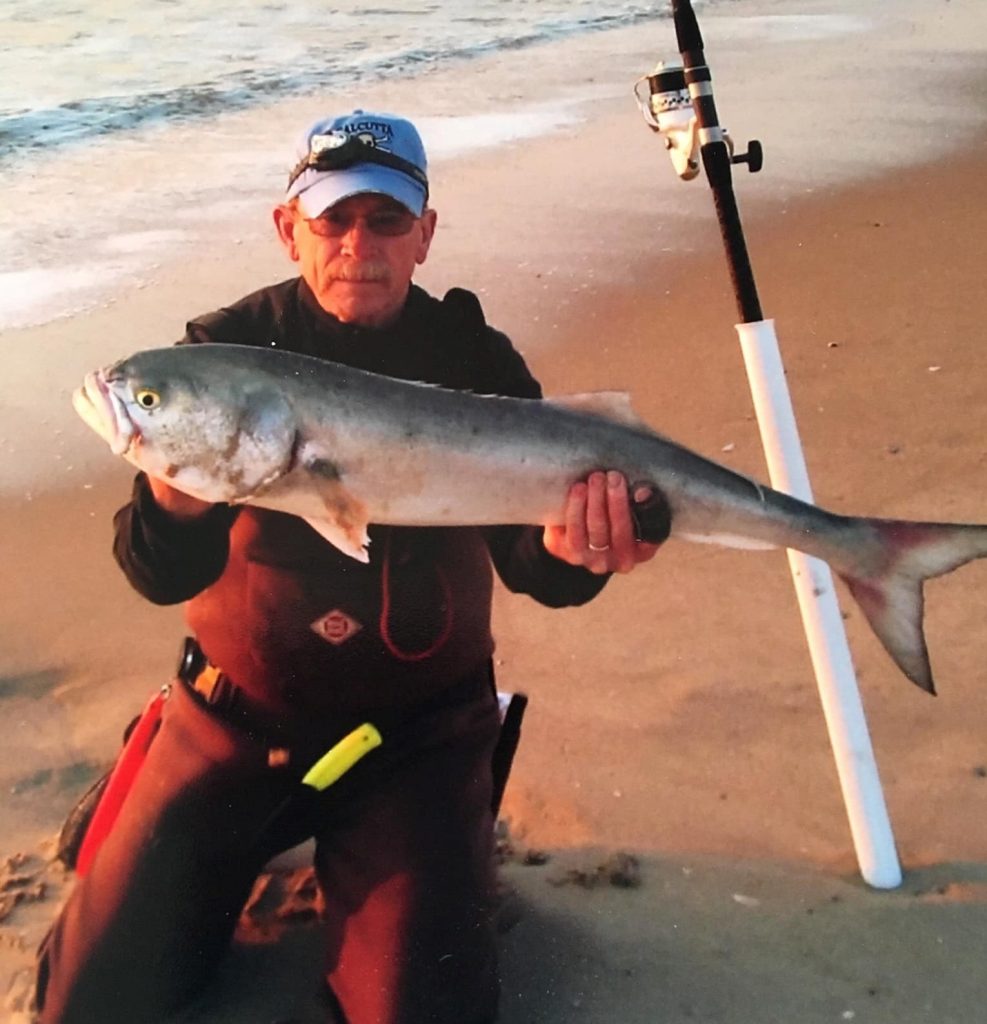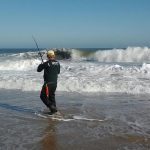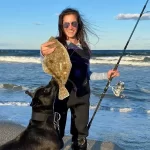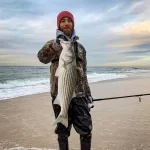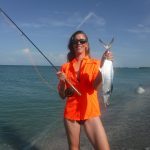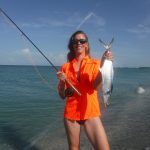Surf Fishing Tackle and Techniques, a Complete Guide
This article will thoroughly cover surf fishing tackle and techniques. There is something magical about standing on the shores of an ocean and casting a lure or bait out into it in search of fish. In some ways, surf fishing is very simple and basic. However, there are nuances that will be the difference between success and a slow day. These techniques along with surf fishing tackle, rigs, baits, and more will be discussed.
Best surf fishing rods and reels
Like most sports and hobbies, some equipment will be needed in order to participate. While surf fishing is fairly simple and uncomplicated, it does require some special fishing tackle. All of the rods, reels, hooks, sinkers, line, and other gear needed will be covered thoroughly and in detail.
Spinning tackle is best for surf fishing
The main piece of equipment that an angler will need when getting started surf fishing is the rod and reel. The primary difference between surf fishing outfits and regular inshore saltwater outfits is the length of the rod. 10 foot rods are quite common, but anglers can go as long as 16 feet. Longer rods are used to make further casts as well as to keep the line up over the crashing waves.
The majority of surf fishing situations, spinning tackle is the best choice. It is certainly easier for novice anglers to learn to use. Spinning tackle is easy to use and versatile. Also, with the spool being exposed, it is easier to rinse the sand off when the rod falls, which will invariably happen.
Conventional, or bait casting, tackle does have its place in surf fishing as well. In fact, in the hands of a skilled angler, it will outperform spinning tackle in most cases. It is more difficult to master.
Surf fishing rod and reel combinations
Anglers can get by with one basic surf fishing outfit. However, to really cover all the circumstances and situations that may arise when surf fishing, three outfits will be needed. These are a 7 foot medium spinning outfit, a 10 foot medium surf fishing outfit, and a 13 foot to 15 foot heavy surf fishing rod and reel.
Light spinning outfit
A 7 foot medium or medium light spinning outfit will catch a lot of fish in the surf. A 7 foot rod with a fast action and paired with a 3000 series reel is a great all round combo. The good thing is, many saltwater anglers already own a suitable light tackle rod and reel such as this. It is perfect for casting lighter lures such as jigs and spoons. Often times, fish will be found close to shore, right in the first trough. Casting these lighter lures can be the most productive technique to catch fish in this situation. 10 lb monofilament or braided line works well.
Anglers can shop at Amazon for a Daiwa Black Gold reel and St Croix Triumph 7′ MF rod spinning combo in this link.
“Fishing Lido Key is a participant in the Amazon Services LLC Associates Program, an affiliate advertising program designed to provide a means for sites to earn advertising fees by advertising and linking to Amazon. As an Amazon Associate I earn from qualifying purchases.”
Medium surf fishing outfit
The second rod and reel combination would be a 10 foot rod paired up with a 6000-8000 size reel. This is a versatile combination, and if anglers had to only choose one outfit with which to surf fish, this would be the best choice. It is long enough and heavy enough to soak a cut bait on the bottom while still being suitable for casting larger lures such as spoons and plugs to breaking fish. it can be spooled up with 15-20 lb braided or monofilament line.
Click to Shop Amazon for a Penn 10′ medium heavy surf rod and reel
Heavy surf fishing outfit
The third outfit would be a heavy outfit between 12 feet and 15 feet long. These are known in North Carolina as “Hatteras heavers” as they are used to cast heavy weights a long way over the breaking surf. Of the three outfits, this one can be omitted by anglers who do not think that they will be doing this type of fishing very often.
Click to shop Amazon for a 12′ to 15″ surf rod and 12000 surf reel
Many anglers take a two-pronged approach when surf fishing. By having these several different outfits, live or cut baits can be soaked on the bottom while the rods sit in a rod holder. Anglers can then work the trough close to shore with the lighter spinning outfit while waiting for a bite on the heavier rigs. This is a versatile way to approach surf fishing, and often times the most productive.
Surf fishing rigs
There are two basic rigs that will cover the majority of surf fishing situations. These are the fish finder rig and the high low rig, also known as a spreader rig or chicken rig. Some anglers will use other specialized rigs or variations, but these two basic rigs will get the job done and just about every situation.
Fish finder rig
The fish finder rig is a staple among surf fisherman everywhere. The main component is a device called a slider. The running line passes through a hole in the slider and then a swivel is attached. A leader is then used between the swivel and the hook. The leader lengths will vary depending on the situation, but generally around 2 feet or so is used. Some anglers will put a small float near the hook to lift the bait up off the bottom, especially when crabs, sharks, and skates become a nuisance.
The slider has a clip on it which makes changing sinkers quick and easy. Most anglers use pyramid style surf fishing sinkers with these rigs. When cast out, the sinker will dig into the bottom and hold. The hole in the slider will allow a fish to pick up the bait and move off with it without feeling the weight of the sinker. This is an extremely productive and effective rig, especially when fishing for larger species.
High low rig
The high low (AKA chicken rig and spreader rig) is a very basic bottom fishing rig used by anglers surf fishing. It is also used extensively by those vertically bottom fishing from boats and piers as well. The advantage of this rig is that multiple baits can be presented at varying depths. This rig is most often used when fishing for smaller species such as whiting and pompano. However, larger fish can certainly be caught by anglers using this rig as well.
The high low rig consists of a sinker at the bottom and then multiple hooks at several different depths coming off of either the mainline or a prepared rig. Most tackle shops that cater to surf anglers will have ready-made rigs for sale. Some of these consist of wire arms that protrude off to the side, spreading the baits out. Anglers can quickly and easily tie their own by simply using dropper loops. Pyramid sinkers are mostly used, though bank sinkers can be used as well.
Surf fishing sinkers
Most anglers surf fishing will use pyramid style sinkers. These cast well and will generally hold the bottom, unless the current is very strong. In some types of fishing, it is desired to have the bait bouncing along the bottom. In most surf fishing situations, this is not the case. It is preferred to have the bait anchored in one spot. Anglers who desire the bait to move about the bottom will use a sliding egg sinker in place of the fish finder slider.
For most anglers surf fishing, 3 ounce or 4 ounce weights will work fine. As in all fishing, the size of the weight can be adjusted to the given conditions. Often times, anglers are dealing with wind right in their face, limiting casting distance. Heavier sinkers may be required in this situation. Conversely, on calm days when the fish are not too far out, a lighter sinker may be a better choice. Anglers using heavy rods and large baits will often go up to 6 ounces or even 8 ounces of weight.
Surf fishing hooks
Hooks come in a myriad of sizes and designs. Anglers often make the mistake of using too large a hook. The hook size should match the size of the bait being used, not the size of the fish being targeted. In most situations, a short shank, stout, live bait hook is the best choice. Some of these hooks have little barbs on the shank which helps hold the bait on the hook. These are called bait holder hooks for obvious reasons. Flounder and fluke anglers will sometimes use a long shank hook.
In Maine and other parts of the Northeast, circle hooks are required to reduce fish mortality. Many anglers have switched over to circle hooks even when not required by law. A circle hook has a unique design which most often results in the hook rotating and ending up in the side of the fishes mouth. This certainly reduces fish mortality, especially when using cut bait.
Fishing line choices
The best line for surf fishing is a matter of debate. The two basic choices are monofilament and braided line. Like most things in life, each comes with its advantages and disadvantages. It really just comes down to personal choice Monofilament line is less expensive, knots are easier to tie, and the line is easier to manage. However, monofilament line will twist up and need to be replaced much more often. It is probably the best choice for beginners and novice anglers. In most situations, 20 pound monofilament line is a good all-around choice.
Braided line is much more expensive, however it lasts a long time. Braided line is much smaller in diameter when compared to monofilament lines of the same strength. It also has no stretch, which is both good and bad. Strikes are very easy to detect. However, the drag needs to be set a bit lighter as there is no stretch in the line from a surging fish when being landed. Finally, knots can be a bit more difficult to tie with braided line. Anglers most often used 30 pound to 40 pound braided line on their surf fishing tackle.
Other surf fishing gear
There are a few other pieces of gear that anglers will want when heading out surf fishing. Sand spikes are essential! They allow anglers to bottom fish with one rod or more as well as casting lures with a lighter outfit. Even if anglers do not plan on bottom fishing, a sand spike gives anglers a place to put the rod up out of the sand while re-rigging or taking a break.
Pliers
A good pair of saltwater resistant fishing pliers is another basic piece of equipment that all surf fishing anglers will need, for obvious reasons. Anglers will need to work on their terminal rigs as well as release fish. Pliers is assistant both of these situations.
Surf fishing cart
Some serious surf anglers either purchase or build a cart. These can be very handy when getting all of the tackle and gear required out to the beach and back. This is particularly true in places were anglers can’t park very close to their fishing spot. They can be made cheaply and easily using PVC pipe from the hardware store. Carts can also be purchased commercially.
Knives and cutting boards
Surf fishing anglers will need a cutting board and a couple of different knives as well. An inexpensive bait knife can be used to cut fresh or frozen bait. The fillet knife can be used for this as well, though some anglers prefer to save the blade when filleting a fish. Some type of cutting board comes in handy for both cutting bait and filleting fish.
Surf fishing techniques
Many entire books have been written about surf fishing. In this section, some basic tips, techniques, locations, and species will be covered. Fishing in the surf is no different than fishing anywhere else and fish have similar requirements. Game fish will look for advantageous spots to stage where they can feed efficiently and easily. Obviously, some type of forage needs to be present. One different aspect of surf fishing as that most often there is no cover present.
Reading the surf
One of the most difficult things for novice surf fishing anglers to learn is how to read the beach. Experienced anglers will stand on the beach and scan the horizon and pick out areas where fish are more likely to move through and be located. While this really only comes with experience, there are few tips that will help novice anglers achieve success a little more quickly.
The waves are the best indicator as to what is going on below the surface. The further out a wave breaks, the more shallow the water. Gaps in between areas of breaking waves often signal a deeper trough or hole. This can be a prime spot to fish! Also, the further the water pushes up on the beach when it hits the shore often indicates a slightly deeper area. These depth changes are subtle, only a few feet, and they make a huge difference when it comes to fish locations and movements.
While most angler surf fishing prefer the higher tide stages, anglers can learn a lot about the beach by doing some scouting on the lower tide stages. This is particularly true on the extreme low tides. During these times, anglers will be able to better pick out sandbars, cuts, troughs, and holes that can be likely fish holding spots when the tide comes in.
Importance of tides when surf fishing
Tides are one of the most important factors to consider when saltwater fishing, and surf fishing is no exception. The two most important factors are the height of the tide and the strength. It can be very difficult fishing when the tide is running hard. Even large weights will not hold bottom and the bait will roll and tumble in the current. This is especially true up north, were tides can exceed 10 feet of movement and six hours. Capt. Jim ran into this one fish in old Orchard Beach Maine for stripers in the fall several years back.
One tried-and-true rule that seems to hold up well no matter where angler surf fish is to fish two hours before and after the high tide. As the tide reaches both high and low, the current flow eases up and then eventually stops before changes direction. In many situations, due to thermal dynamics, this results in the wind easing up as well. If anglers can time this high tide with dusk or dawn, so much the better!
However, don’t let perfect be the enemy of good. The old saying that the best time to go fishing is whatever you can pretty much holds up. Each trip will bring an angler more experience as conditions change constantly with each fishing trip. The only time Capt. Jim will really cancel a trip is when it is extremely windy and the surf conditions too rough. Fishing cannot only be difficult, it can be dangerous under these circumstances.
Best surf fishing baits
The best baits to use when surf fishing will very depending upon a geographical location. In most situations, anglers not familiar with the area will do best to visit a local bait and tackle shop that caters to anglers surf fishing. They will get some excellent advice that will save them a lot of time regarding both fishing conditions, spots, and the best baits to use.
From the Carolinas south around Florida and over to Texas, it is tough to beat either fresh or frozen shrimp. Everything and saltwater eats these tasty little critters! Shrimp are also easy to obtain and fairly economical. Most anglers agree that fresh shrimp is better, however frozen shrimp will work fine in most situations.
The majority of surf fishing anglers who fish with bait or use some variety of cut up fish or other marine animal such as clams, squid, and oysters. In many cases, anglers use one of their lighter rods to catch a smaller fish and then use it for bait. It is important to make sure that it is a legal fish and that all regulations are being obeyed. It is really tough to beat a fresh cut a piece of fish that is locally available. Cut bait also stays on the hook longer than any other bait. These fish vary greatly depending on the area being fished.
Anglers who do not want to catch their own bait can certainly buy it as well. Local bait shops will have a good supply of bait as well as information as to what the fish are hitting. Squid is a great all round bait for a variety of species anywhere on the planet. It is easy to use and stays on the hook pretty well. Anglers fishing with cut squid or cut bait will either use a strip or a chunk, depending on the species being targeted. Smaller chunks are better for smaller fish on a high low rig. Larger strips work better on a fish finder rig when targeting larger species.
There are a few other baits that anglers can you surf fishing as well. Bloodworms and sandworms are popular baits in the Northeast. They are a bit expensive but are also quite effective. Clams and oysters are used by some anglers as well. Clams stay on the hook better than oysters do. Finally, in some parts of the country crabs are used. In the southern part of the country and along the Gulf Coast, mole crabs, also known as sand fleas, are a popular surf fishing bait.
Best surf fishing lures
Artificial lures can be extremely effective for anglers surf fishing as well. The main three types of artificial lures that are used are spoons, plugs, and jigs. These are basically the same lures that anglers have been using and saltwater from boats and from shore for a long time. One difference anglers have one casting lures from the surf is that the bait needs to be fairly heavy as anglers are often times facing a fairly stiff breeze.
Click to read about the 7 essential surf fishing lures
Jigs
Jigs are very effective lures to use when fishing the surf. Anglers most often used them when blind casting. By this we mean when fish are not seen actively feeding on the surface. Capt. Jim was visiting Nags Head in the spring a few years ago and the most productive technique for most of the anglers was casting a 1/4 ounce jig and grub combination into the first trough right near the shore. Bluefish and spotted sea trout were plentiful!
In most situations, anglers casting jigs will find fish in this location, the first deep trough off of the beach. Game fish will run parallel to the shore in search of food. A jig cast out and bounced along the bottom can be an extremely productive way to catch a variety of species. Jigs between 1/4 ounce and 1 ounce work best. A white buck tail jig is extremely effective. Many anglers have gone to the jig and grub combination, as it makes changing the tail quick and easy.
Spoons
Spoons are another very effective surf fishing lure. A spoon is basically a curved piece of metal with a hook in it. While they come in a variety of colors, most anglers casting off the beach use silver as it imitates locally available forage fish the best. Spoons also come in a variety of sizes to match the local bait fish.
One of the advantages of using spoons is that they can be cast a long way. This can be very important when fish are seen breaking just outside of the first bar. This is too far for anglers casting a small jig on a light spinning rod. That 10 foot outfit will cast a three or 4 ounce spoon far enough to get in on the action. Spoons can also be used to blind cast in area. They are very effective search baits is a lot of water can be covered in a fairly short amount of time.
Plugs
Plugs are basically chunks of plastic or wood that resemble wounded bait fish. Surf fishing anglers are especially fond of using surface plugs such as pencil poppers. This type of fishing is great fun as anglers can see the strike. Striped bass and bluefish are often caught by anglers surf fishing with top water plugs in the Northeast.
Subsurface plugs, or jerkbaits, generally float on the surface and then dive down a few feet when retrieved. They are more often times more effective than top water plugs, though the strike is not quite as exciting. Plugs come in a wide variety of sizes, shapes, colors, and styles. Once again, local bait shops are by far the best resource to pick up the best plug for the area being fished.
Top surf fishing species
There are a wide variety of species that anglers can catch when surf fishing in the United States. It would be impossible to cover them all, the Capt. Jim will list the top species as well as the range that they inhabit and a tip or two to catch them.
Striped bass
Striped bass are arguably the most popular species targeted by anglers surf fishing. They are found from the Outer Banks in North Carolina up to Maine. The season with which they can be caught will vary depending on the geographic location. Striped bass stocks seem to fluctuate quite a bit. This results in fish management constantly changing the regulations in order to protect the species. Anglers need to stay abreast of these laws when fishing for striped bass.
Stripers can be caught by anglers using both natural bait and artificial lures. Striped bass are an apex predator that grow very large, with some specimens pushing 100 pounds. Fresh cut baits such as pogies, menhaden, and mackerel work well. Any freshly caught fish, especially oily ones, will catch striped bass. Blood worms, sandworms, crabs, and even live eels are top natural baits.
Striped bass will take just about any artificial lure as well. A white buck tail jig with a strip of squid is an excellent choice as it combines both and artificial lure with the scent and smell of bait. Jig heads with larger swim baits are productive as well. Silver spoons and plugs are excellent lures to cast, especially when fish are seen feeding on the surface.
Bluefish
Bluefish are another popular species caught by anglers surf fishing. Larger bluefish are caught in the Northeast and down to the Carolinas, while in Florida and along the Gulf Coast bluefish average a couple pounds. They are a very hard fighting and aggressive fish and are an excellent species to catch from the beach.
Bluefish are a schooling fish that are voracious in their feeding habits. In fact, they are one of the few if not the only species that will regurgitate its food so that they can keep feeding even when they are full. Many of the “blitzes” that surf fishing anglers talk about involve bluefish. They do have very sharp teeth and anglers will often times opt for a wire leader when bluefish are plentiful. However, this will often times reduce the number of bites, so anglers will have to make the decision as to which is more important.
Bluefish will hit just about any live or cut bait as well as flashy, erratic, fast-moving artificial lures. Silver spoons are excellent lures to use when targeting bluefish. Most anglers choose not to use plugs for them, as the treble hooks can be tough along with the chance of the bluefish biting off an expensive plug. A swim bait on a jig head works quite well, too. Just about any piece of fresh cut bait will produce bluefish when fished on the bottom.
Fluke and flounder
There may not be any other species that are prized more than fluke and flounder are by anglers surf fishing. While they put up a decent fight, these fish are prized for their snow white fillets. Known as fluke in the Northeast and flounder south of New Jersey, they are basically the same fish and habits.
Flounder and fluke are bottom dwelling species that bury themselves in the sand and ambush prey as it goes by. That is the reason one side of the fish is white, the other side is camouflaged and both eyes are on the same side of the head. Obviously, the best presentation is one on or near the bottom. While some flounder and fluke are caught by anglers bouncing jigs, particularly with a live or frozen minnow or strip of cut bait, most fish are caught by anglers bottom fishing. Top baits include minnows either live or frozen, squid, and strips of cut bait.
Spanish mackerel
Spanish mackerel are an aggressive, schooling fish that are found from the mid-Atlantic states south. They are beautiful, fast, and put up a terrific fight. They are often times found feeding on the surface and will attack any fast moving lure or fly. Spanish mackerel are good eating when prepared fresh that day or the next, but they do not freeze well. They also make terrific cut bait for striped bass, sharks, bluefish, and other species.
Spotted sea trout
Spotted sea trout, also known as speckled trout, become a prime surf fishing target from the mouth of Chesapeake Bay south. These are a schooling fish that are very beautiful and put up a decent little battle. They are outstanding on a dinner plate! Most are caught by anglers casting a jig head with a grub body on it fairly close to shore. However, they will certainly take a fresh bait fished on the bottom, especially shrimp.
Red drum
Red drum, also known as redfish or reds are an extremely popular game fish that are found from Virginia south along Florida and along the entire Gulf Coast to Texas. Redfish vary greatly in size from small rat reds to the giant bulls of over 50 pounds. Smaller redfish in the 20 inch to 25 inch range are generally considered the best to eat. In many states, fish over 27 inches must be released.
Artificial lures catch many redfish for anglers on the shallow flats and bays, and they will catch a few fish in the surf. However, the majority of red drum and landed by anglers surf fish and are done so using natural bait. A chunk of fresh mullet is tough to beat. Half a blue crab or a large shrimp will work as well. Redfish do tend to school and when the bite is on the action can be hot.
Whiting
Whiting are a top prize of angler surf fishing, both for their spirited tussle given their size and their fantastic eating! Also known as surf mullet, whiting are a schooling fish and once located the action can be fast and furious. They are best targeted by anglers fishing with medium-size surf rods, fairly small hooks, and pieces of shrimp. A few may be taken by anglers using artificial lures, but the majority will be taken on bait. They are widely distributed along the Atlantic and Gulf coasts.
Sharks
Surf fishing for sharks, especially large ones, is a bit of a specialized pursuit. Anglers will often times use very heavy tackle and even sometimes use kayaks and row offshore in order to get the bait out a ways from the beach. However, smaller sharks can be great fun for anglers fishing with normal surf fishing tackle. If sharks are around, a strip or chunk of fresh bait on the bottom will catch them. Some species are good to eat, but anglers need to check local regulations and be very careful when handling sharks.
Pompano
Pompano are a highly desirable species caught in the surf from Chesapeake Bay south. The average a couple pounds and put up a terrific fight for their size. There may not be a better eating fish in the sea! Pompano can be caught by anglers surf fishing in saltwater by using small jigs, often times tipped with a piece of shrimp. Most pompano are caught by anglers using a high low rig with either pieces of shrimp or sand fleas.
Bottom fish
There are a variety of bottom fish that anglers can catch when surf fishing. These include croaker, spot, white perch, scup, sheepshead, and more. Most of these fish are caught by anglers using small pieces of cut bait or shrimp on smaller hooks. While not huge, they can be fun to catch, especially when a fish fry is the result.
In conclusion, this article on surf fishing tackle and techniques will help anglers catch more fish off of the beach!
